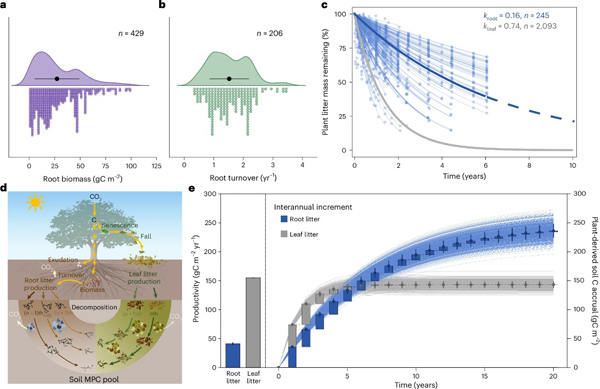The Finest Roots Promote Forest Soil Carbon Accrual through Iterative Effects
Since the 1980s, it is known to us that fine roots (< 2 mm) play an important role in ecosystem carbon (C) cycling, and their contribution to soil C accrual may exceed their aboveground counterpart (i.e. leaves). Despite this claim lasting for over 40 years, the role of multi-decadal root iterative dynamics (i.e. growth, turnover, and decomposition) in soil C accrual remains unresolved, especially for the finest and metabolically active roots, namely absorptive roots (the most distal two or three root orders or the finest roots < 0.5 mm in diameter).
Prof. KOU Liang’s team at the Institute of Geographic Sciences and Natural Resources Research (IGSNRR) of the Chinese Academy of Sciences (CAS) and their collaborators found owing to fast turnover and slow decomposition, the iterative effects of absorptive roots on soil C accrual generate 2.4 ± 0.1 MgC ha-1 over two decades, exceeding that of leaves by 65%.
This study was published in Nature Geoscience.
“The accrual of soil C from absorptive fine roots exceeds that of leaf litter in forests despite lower productivity, according to an analysis of field observations from Northern Hemisphere forest sites,” summarized by Editor Tamara Goldin.
The researchers assembled a dataset encompassing 880 field observations on the growth, turnover and decomposition rate of absorptive roots from 199 woody species across 328 forest sites in the Northern Hemisphere.
This work relates to a current hot topic in soil science and forest ecology. Since forest soil is one of the largest terrestrial C stocks, a major achievement of this work is to bring critical estimates on the iterative effects of absorptive roots necessary to accurately characterize the moderately-persistent forest soil C pools.
Furthermore, a heated scientific debate has arisen regarding whether arbuscular mycorrhizal-dominated or ectomycorrhizal-dominated forests store soil C at a higher rate. This study helps address the current controversy with challenging new findings. Roots associated with arbuscular mycorrhizal fungi contribute 43% more soil C than roots associated with ectomycorrhizal fungi, despite ectomycorrhizal forests dominating soil C storage in forest soils overall.
Global biogeochemical cycling models also urgently need reliable belowground metrics to integrate the influence of plant roots in the global C cycling models. In this respect, this study identifies that specifics root length, the most predictive metric, can capture absorptive root dynamics on the C cycle, which provides a tractable and long-needed belowground metric for global C models.
Previous studies on soil C stabilization have focused on the microbially-dominated and highly-persistent forms of soil C, while this study substantiates the leading contribution of absorptive roots to the moderately-persistent forest soil C pool. Given its prominent role in the maintenance of soil biodiversity and functioning, the moderately-persistent forest soil C pool might attract increasing attention in future global soil assessments. In the context of global biodiversity loss and shifts in forest mycorrhizal types, this study is essential for integrated quantification and accurate modeling of soil C stock in the Earth system.

Fig. 1 Carbon-based dynamic processes and iterative effects on soil C accrual of absorptive roots in Northern Hemisphere forests (Image by KOU’s team)
Reference:
N. Ma, S. Li, M. L. McCormack, G. T. Freschet, P. Ciais, H. Wang, S. Niu, P. B. Reich, M. Zhang, R. Zhao, B. Zhao, D. Gao, A. Gessler, Y. Huang, J. Gu, X. Fu, X. Dai, S. Meng, J. Zheng, F. Yang, L. Kou. Substantial forest soil carbon accrual from absorptive fine roots over decadal timescales. Nat. Geosci. (2025) doi: 10.1038/s41561-025-01790-5.
Download attachments: